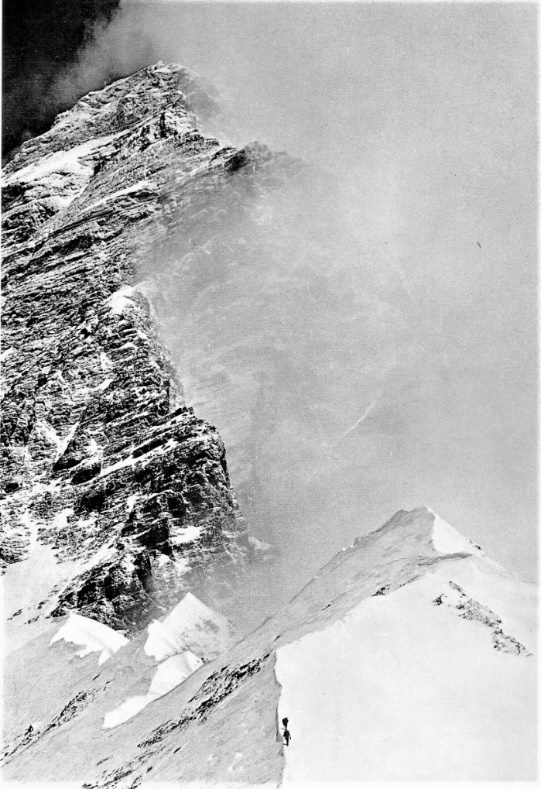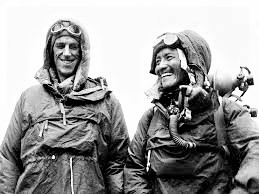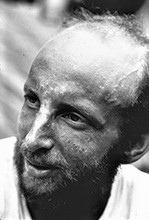
What did the first few summiteers say when they reached the top of Mount Everest?
We barely know, for on the first three successful attempts between 1953 and 1963, the focus was more on getting mountaineers up there and back, alive, than fussing over what to speak for posterity.
The Brits were first, in 1953, followed by the Swiss in 1956, and the Americans in 1963. Here’s what the Brits and the Americans said and did on top of it all. They appear to have received the bulk of the press coverage back then.
The 1953 British Mount Everest Expedition
Long after Sir Edmund Hillary and Tenzing Norgay were the first to summit Everest, Hillary described how elated, surprised, and satisfied he was with the achievement. They reached the top, close together, at 11:30 a.m., Friday, May 29, 1953. Though a lot has been written about those few high moments of long-lasting fame, we have no hint of what Hillary actually said while standing at the highest point on earth. In his autobiographical View from the Summit, he describes how tired they were, moving slowly upward, seeking “rather anxiously for signs of the summit.” And then, he saw the barren plateau of Tibet in the distance, and directly in front of him: The Summit.
Afterward, when word of their success flashed around the world, the international press groused loudly about Hillary claiming the lead during the few last steps to the top. In his book, however, Hillary carefully side-steps the fuss. As they approached the snowy dome, he writes, “We drew closer together as Tenzing brought in the slack on the rope. I continued cutting a line of steps upwards. Next moment I had moved onto a flattish exposed area of snow with nothing but space in every direction. Tenzing quickly joined me and we looked around in wonder. To our immense satisfaction, we realized we had reached the top of the world!”
Then, “In typical Anglo-Saxon fashion,” he says, “I stretched out my arm for a handshake, but this was not enough for Tenzing who threw his arms around my shoulders in a mighty hug... With a feeling of mild surprise I realised that Tenzing was perhaps more excited at our success than I was.”
How Tenzing felt and what he said on top is written his autobiography Tiger of the Snows. Tenzing did something remarkable, shouting out in triumph and thankfulness at the top: “Thuji chey, Chomolungma”—I am grateful, Goddess Mother of the World! In that moment atop the holy of holies, at 29,029 ft., Tenzing Norgay was the highest and happiest Sherpa in the world.
During their 15 minutes on top, Hillary photographed Tenzing holding an ice axe with a small Union Jack and the flags of Nepal, India, and the United Nations tied to it. But, alas, he forgot the obligatory photo of himself at the summit. No selfies.
More than anything else uttered that day on mountain, however, it is what Hillary said to George Lowe, the first expedition member he met after coming down from the summit, that will doubtlessly be remembered the longest—“Well, George, we knocked the bastard off!”
The 1963 American Mount Everest Expedition
In 1963, six members of the AMEE became the third set of climbers to reach the peak, and now the search for words spoken on top takes on a whole new dimension.
On Wednesday, May 1, Jim Whitaker and Nawang Gombu topped out at 1 p.m., after ascending the same Southeast Ridge route the Brits had pioneered and the Swiss had followed. In Americans on Everest, the official account, author James Ramsey Ullman describes the scene:
“Jim, in the lead, stopped and waited for Nawang Gombu Sherpa to come up to him. ‘You first,’ he said. ‘No, you,’ said Gombu. Then, the dome being wide enough, they walked side by side to its top. Beyond, everything fell away. And they were there.”

Jim recalls slapping Gombu on the back, that they hugged each other, and how so “very, very cold” it was that their fingers and toes were numb. With the temperature hovering around minus 30 degrees Fahrenheit they didn’t tarry, but soon turned and started back down.
Three weeks later to the day, four more Americans summitted, in pairs. Barry Bishop and Lute Jerstad ascended the same Southeast Ridge route, while Tom Hornbein and Willi Unsoeld pioneered the challenging West Ridge. In his book Everest: The West Ridge (1964), Hornbein writes that during a brief noontime chat by radio with Base Camp, Willi described the West Ridge as (abbreviated here):
“a real bearcat! ... too damned tough to try to go back ... too dangerous ... absolutely no rappel points ... nothing to secure a rope to.”
Talking into the mike while clinging precariously to the rock face, he looked down and up and concluded:
“it’s up and over for us today ... we’re headed for the summit.”
The West Ridge ascent made mountaineering history. It had never before been attempted, and never successfully repeated. And—leave it to the Americans!—everything said in radio chit-chat that day was recorded for posterity!
Both teams hoped to meet up on top at midday to celebrate their achievement together, but it didn’t happen. Instead, according to the summit chronology tersely encapsulated by Hornbein:
“May 22: Barry Bishop and Lute Jerstad reach summit of Everest via South Col route at 3:30 p.m. Willi Unsoeld and Tom Hornbein arrive three hours later up the West Ridge, then descend toward South Col. The two parties unite after dark and spend night out at 28,000 feet.”
When Barry and Lute found no sign of the others on top, they started wearily back down toward the South Col. When Tom and Willi topped out around 6:30 p.m.—dangerously late for anyone on Everest—they found only fresh boot prints on the summit mound and the tattered, wind-whipped flag Jim Whitaker had put there on May 1st.
It was midnight before the two teams finally met up. Because it was too precarious to stumble on in the dark with dead flashlights, the four men huddled together in the snow at 28,000 feet and with few words survived what was hailed as the highest bivouac in mountaineering history, at that time.
Reflecting back on their top-most moments, Hornbein writes:
“We felt the lonely beauty of the evening, the immense roaring silence of the wind, the tenuousness of our tie to all below. There was a hint of fear, not for our lives, but of a vast unknown which pressed in upon us ...”
As oxygen-starved and exhausted as they were, however, no words could have been spoken as candidly in the moment.
All day long, support team members down at Advanced Base were scanning the summit through binoculars, and they kept the walkie-talkie radio on for any action from above. About 5:30 p.m. they caught a glimpse of Lute and Barry, but they neither saw nor heard from Willi and Tom. It wasn’t until late, around 7 o’clock, while Maynard Miller (one of the expedition scientists) was listening, that quite suddenly—"electrifyingly”—he later told Ullman for the record:
“the radio came alive with Willi Unsoeld’s voice. He and Tom had just come off the summit, he said. They were a few feet below it. They were about to descend the Southeast Ridge.”
Willi’s words faded in and out of the static and howling wind, then drifted back―
“Faintly, very faintly. And it seemed to the incredulous Maynard that what he was hearing from up there was poetry....”
Willi was reciting the last lines of ‘Stopping by Woods on a Snowy Evening’ by the American poet Robert Frost:
“...I have promises to keep,
And miles to go before we sleep,
And miles to go before we sleep.”
“Ever the gentleman, even at 29,000 feet,” writes Ullman, Willi had changed Frost’s original “I sleep” to “we sleep,” to include Tom; and those “promises to keep” were to his wife Jolene, that Everest would be his last “big mountain.”


Frost’s ‘Stopping by Woods...’ has been described as “one of America’s most revered and recited poems,” known for its “moody pondering of mortality.” Like an elegy.
‘Stopping by Woods on a Snowy Evening’
Whose woods these are I think I know.
His house is in the village, though;
He will not see me stopping here
To watch his woods fill up with snow.
My little horse must think it queer
To stop without a farmhouse near
Between the woods and frozen lake
The darkest evening of the year.
He gives his harness bells a shake
To ask if there is some mistake.
The only other sound's the sweep
Of easy wind and downy flake.
The woods are lovely, dark and deep,
But I have promises to keep,
And miles to go before I sleep,
And miles to go before I sleep.
(Robert Frost, 1923)
Sometime later, when Willi lectured about climbing the West Ridge, a member of one audience suggested either Willi or Tom could just as well have quoted the last three lines of another Frost poem, ‘The Road Not Taken’:
“...Two roads diverged in a wood, and I,
I took the one less traveled by,
And that has made all the difference.”
_______________________________________
Chomolungma, ‘Goddess Mother of the World’, is the Sherpa and Tibetan name for Mount Everest (Sagarmatha in Nepali). To date, over 4,000 people have reached the top, but few of them have done it with the same spirit and style as their earlier predecessors. Books quoted in this story are Edmund Hillary’s View from the summit (1999), Tenzing Norgay’s Tiger of the Snows (1955, written in collaboration with James Ramsey Ullman), Tom Hornbein’s Everest: The West Ridge (1964), and James Ramsey Ullman’s Americans on Everest (1964). It was Steve Hendrix who called Frost’s poem a “moody pondering of mortality” in a January 1, 2019, article in The Washington Post, entitled ‘Robert Frost Wrote This Masterpiece...’ The two poems quoted here are Frost’s most popular―all the way to Everest!










